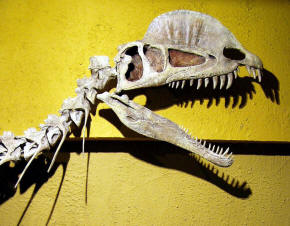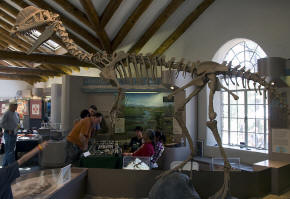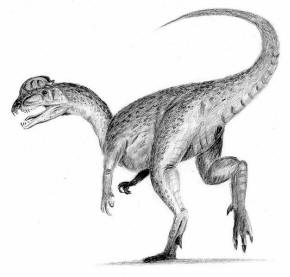|
Description
Dilophosaurus measured around
six meters (20 ft) long and may have weighed half a ton. The most
distinctive characteristic of Dilophosaurus is the pair of rounded crests on
its skull, possibly used for display. Studies by
Robert Gay show no indication that
sexual dimorphism was
present in the skeleton of Dilophosaurus, but says nothing about crest
variation. The teeth of Dilophosaurus are long,
but have a fairly small base and expand basally.
Another skull feature was a notch behind the first row of teeth, giving
Dilophosaurus an almost crocodile-like appearance, similar to the putatively
piscivorous (fish
eating)
spinosaurid dinosaurs.
This "notch" existed by virtue of a weak connection between the
premaxillary and
maxillary bones of the skull. This
conformation led to the early hypothesis that Dilophosaurus scavenged off
dead carcasses, with the front teeth being too weak to bring down and hold
large prey.
Classification
|
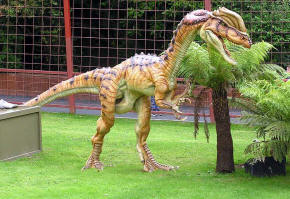
|
|
Above: Animatronic reproduction of Dilophosaurus
Below: Head of a model Dilophosaurus wetherilli
nicknamed "Dyzio" in the Geological Museum of the Polish Geological
Institute in Warsaw. (Picture
Source)
|
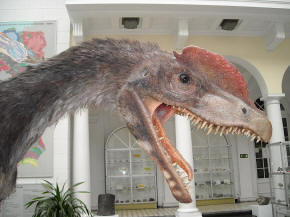 |
Dilophosaurus
may be a primitive member of the
clade containing both
ceratosaurian and
tetanuran theropods.
Discovery
The first
Dilophosaurus specimens
were discovered by Sam Welles in the summer of 1942.
The specimen was brought back to Berkeley for cleaning and mounting, where
it was given the name Megalosaurus wetherilli.
Returning to the same formation a decade later to determine from which time
period the bones dated, Welles found a new specimen not far from the
location of the previous discovery. The specimens were later renamed
Dilophosaurus, based on
the double crest clearly visible in the new skeleton.
In Popular Culture
Dilophosaurus
appeared in the novel
Carnosaur, in which a
member of the genus killed a member of Parliament.
Dilophosaurus
was prominently featured both in the 1993 movie
Jurassic Park and in
the original novel by Michael Crichton. In the film version,
Dilophosaurus has a
retractable neck frill around its neck (much like a frill-necked lizard),
and spits blinding poison, aiming for the eyes to blind and paralyze its
prey (much like a spitting cobra). There is no evidence to support either
the frill or the venom spitting, which was
acknowledged by Crichton as creative license. In
the film, Steven Spielberg also reduced the size of
Dilophosaurus to 3 feet
(0.91 m) tall and 5 feet (1.5 m) long, much smaller than it was in reality.
Jurassic Park
merchandise, including toys and video games (such as
Jurassic Park: Operation Genesis
and the arcade games The Lost World: Jurassic
Park and Jurassic
Park III), often include
Dilophosaurus.
Despite its inaccuracies, the
Jurassic Park
Dilophosaurus has been taken up by others.
Several other video games, such as ParaWorld
and Jurassic Wars, and Ice Age: Dawn of the
Dinosaurs feature
Dilophosaurus modeled after the representations
in Jurassic Park.
One video game, 2008's Turok,
features Dilophosaurus
based more closely on real fossils and displays their correct size.
Dilophosaurus was also
featured in the documentary
When Dinosaurs Roamed America,
killing an
Anchisaurus and
scaring off a pack of
Syntarsus (now known as
Megapnosaurus).
Return to the
Old Earth Ministries Online Dinosaur
Curriculum homepage.

|
